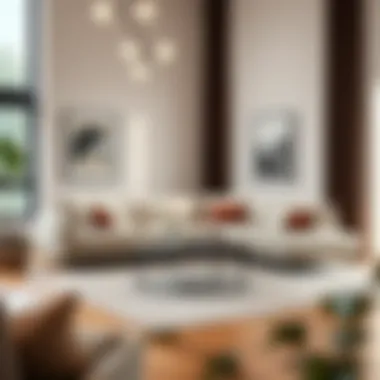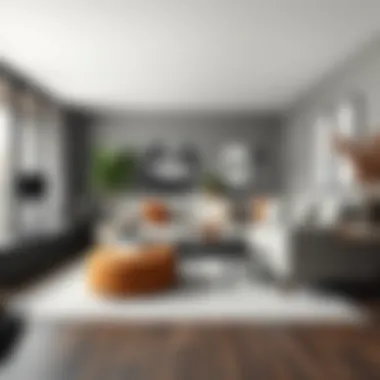Exploring Top Quality Sectionals for Modern Living


Intro
In today's fast-paced world, where our homes serve as sanctuaries from daily chaos, the furniture choices we make carry weight. Nothing seems to define comfort and style in a living room quite like a well-chosen sectional sofa. These versatile pieces not only provide ample seating but also transform the entire atmosphere of your space. Whether you’re looking to host friends or simply lounge after a long day, a quality sectional can significantly enhance your living experience, striking a balance between functionality and aesthetic appeal.
As we embark on this journey to explore the intricate details of sectionals, consider this: what aspects matter most to you? Is it the durability of the materials? The design trends that shape today’s furniture? Or perhaps the interplay of color and texture within your chosen decor? Let's dive deeper into these elements to understand how they contribute to your space.
Furniture Design Trends
Furniture design is constantly evolving, and sectionals are certainly not left behind. They are now available in a wide array of styles that cater to diverse tastes and preferences.
Current Trends in Furniture Design
Today, many homeowners and interior designers are leaning towards minimalism mixed with functionality. Sectionals composed of clean lines, neutral colors, and multifunctional features are becoming increasingly popular. Materials like reclaimed wood, organic cotton, and recycled plastics are not just environmentally friendly but also visually appealing.
Another trend gaining traction is the use of bold colors and textures. From plush velvets to rich leathers, these materials add depth and character to a room. Curved sectionals are also making a comeback, offering a softer, inviting look that’s perfect for creating cozy corners.
Influential Designers to Follow
If you're looking for inspiration, consider following the works of influential designers like
- Kelly Wearstler, known for her eclectic style that combines modernity and traditional elements.
- Jonathan Adler, who injects playful design with bright colors and whimsical shapes.
- Nate Berkus, recognized for his timeless approach that emphasizes comfort and style.
Exploring the creations of these designers can give you a clearer sense of the market's direction and how to select a sectional that is not only trendy but also complements your personal style and needs.
Practical Tips for Furniture Selection
Choosing a sectional isn’t just about liking the look. It requires a thoughtful approach to ensure it fits well within your living space and aligns with your lifestyle.
Choosing the Right Materials
When selecting materials for your sectional, consider the level of use it will endure. Leather and microfiber are great for durability and easy maintenance, while fabrics like linen and cotton offer a cozy touch but might require more care. It's also wise to check the fabric's resistance to wear and tear, especially in homes with pets or children.
Maximizing Space with Smart Furniture Choices
Sectionals can be a real asset in making the most out of a smaller space.
- Look for modular sectionals that can be rearranged to fit your needs.
- Consider sectionals with built-in storage; these can double as multifunctional pieces.
- Adopting a sectional that is appropriately proportioned to your space can prevent overcrowding and make the area feel more open.
"Your home should be a reflection of you, not just a collection of furniture."
By understanding these trends and tips, you’ll be better prepared to invest in a sectional that enhances both your living space and your everyday life.
Understanding Sectionals
In the realm of interior design, sectionals hold a distinguished place. They provide not just seating, but a versatile piece of furniture that can significantly influence a room's layout and aesthetic. Understanding what sectionals are, how they evolved, and their importance in modern living spaces is crucial for anyone looking to maximize their home’s comfort and style.
Sectionals are often characterized by their modular nature. Unlike traditional sofas, they can be rearranged to suit different needs and preferences. This flexibility means you can adapt a sectional based on changes in your living space or lifestyle. Perhaps you frequently host friends for movie nights or need an area for kids to sprawl out—sectionals can easily accommodate those scenarios. They can also serve as impressive focal points in your living room, setting the tone for your design theme.
Defining Sectionals
Sectionals, essentially, are large sofas composed of multiple connected pieces that form various shapes and configurations. They're designed to offer more seating in a compact format, making them an attractive option for smaller spaces. You might find configurations that include a chaise lounge, ottomans, and even recliners, depending on your needs. Unlike standard sofas, sectionals can offer the opportunity for multiple seating styles within one piece of furniture—whether that’s lounging, sitting upright, or reclined comfort.
Here’s what sets sectionals apart:
- Versatility: They can shift and be rearranged, fulfilling different spatial needs over time.
- Design Cohesion: A well-chosen sectional can unify the decor theme of a room, offering a cohesive look.
- Comfort: With generous seating and often customizable options, sectionals are typically built for comfort and easy relaxation.
Historical Evolution of Sectionals
The history of sectionals is as colorful as the fabrics they are covered in. Initial styles can be traced back to the 19th century when furniture began to reflect more casual living spaces. Back then, the notion of a 'sectional' was not yet common. It was the influence of the industrial revolution that spurred mass production of furniture, allowing for more varied styles and designs.
As time marched on in the 20th century, contemporary design emerged in its own right. The mid-century saw the introduction of angular forms and a broader acceptance of unconventional materials. Designers like Charles and Ray Eames began exploring modular designs, which directly led to what we recognize today as the modern sectional. By the late 20th century, sectionals became synonymous with comfort and collaboration, often seen in both residential homes and trendy lofts.
From their rudimentary origins to the polished modern pieces available today, sectionals have adapted to meet the needs of various lifestyles, reflecting social changes, aesthetic preferences, and advancements in manufacturing. Understanding this historical journey adds depth to the appreciation of these versatile furniture pieces.
Importance of Quality
When it comes to furnishing your home, the quality of the pieces you choose can make or break the entire aesthetic and functionality of your living space. Investing in high-quality sectionals, in particular, brings a wealth of benefits that go beyond mere looks.
Durability and Longevity
High-quality sectionals are built to last. Unlike their lower-priced counterparts, they often utilize top-tier materials like robust hardwood frames, sturdy joinery, and premium fabrics or leather. This focus on construction ensures that your sectional not only withstands the rigors of daily use but also looks great for years to come. Imagine a sectional that can bear the brunt of kids jumping, pets lounging, or countless movie nights without showing significant wear. With proper care, a well-made sectional can last a decade or more, proving to be a wise investment.


However, durability doesn't just mean strength. It also encompasses resistance to stains or fading, especially in materials like high-performing synthetic fibers or treated leathers. Taking into account the unpredictable nature of life at home, choosing a sectional that's resistant to wear and tear can save you money in the long run. A sectional that can sustain its original form and function means avoiding the hassle and expense of frequent replacements.
"Investing in quality furniture isn’t just about what looks good in your space. It’s about making a choice that supports your lifestyle and long-term comfort."
Aesthetic Appeal and Design
Quality sectionals don’t just function well; they also elevate the overall design of your space. When you look at a beautifully crafted sectional, it typically showcases intricate details, from fine stitching to carefully chosen materials that complement your decor. High-quality fabrics tend to have richer textures and colors, enhancing the visual experience of your living space.
Moreover, a well-designed sectional can be a centerpiece in your room, inviting conversation and contemplation. The choice of style and color affects mood and perception. For instance, a sleek, modern design can refresh a dull area, while a classic design can add a touch of timeless elegance.
Additionally, there’s an endless array of styles available today, from minimalist to elaborate; therefore, selecting a quality piece means you can make an impactful statement without compromising on comfort. This is particularly vital when considering open floor plans where the sectional serves as a visual anchor in your living area.
Finally, a high-quality sectional will often provide customization options—be it size, fabric, or configuration. This aspect allows homeowners to create a truly unique piece that matches their specific needs and aesthetic preferences, making it more than just furniture—it becomes a reflection of their lifestyle.
Types of Materials Used
When diving into the realm of sectionals, the choice of material is as vital as the design itself. The materials used in crafting these pieces significantly influence their feel, durability, maintenance, and overall appeal. Understanding the different types of materials can aid you in selecting the best sectional for your unique living space while balancing the aesthetics with practical use. This section aims to guide you through the three predominant materials: leather, fabric, and hybrid options, drawing attention to their advantages and considerations in the context of quality and design.
Leather Sectionals
Leather sectionals stand out for their timeless elegance and unmatched durability. Often perceived as a luxury option, leather not only elevates the look of a room but also tends to age gracefully, developing a unique patina over time. One key benefit of leather is its resistance to wear and tear; it can handle the hustle and bustle of everyday life, making it a perfect choice for families.
However, potential buyers should consider the type of leather used. Top-grain leather is highly durable but may come with a higher price tag. Meanwhile, bonded leather offers a more budget-friendly alternative, although its longevity could be compromised with heavy use. Leather sectionals are relatively easy to maintain with just a damp cloth for cleaning, but they can be unforgiving in warmer climates, as they may feel sticky during hot weather.
“Investing in a high-quality leather sectional means investing in a piece that could last decades with proper care.”
Fabric Sectionals
Fabric sectionals, on the other hand, provide a variety of textures, colors, and patterns. They can seamlessly fit into different decor styles, from modern to bohemian. One of the main perks of fabric sectionals is their comfort factor—most fabric covers are soft to the touch, encouraging relaxation. Moreover, the range of materials from cotton blends to polyester allows you to select options that suit your lifestyle, whether you have pets, children, or just like to lounge.
Maintenance might feel a bit more demanding compared to leather, especially with spills. It's important to check the cleanability rating of the fabric. High-performance fabrics, like those treated to resist stains, are ideal for casual households. Some fabrics may even have a more contemporary or warmer aesthetic, enriching the emotional connection to your living space.
Hybrid Materials
Hybrid materials represent an innovative merging of the best characteristics of both leather and fabric. These sectionals often combine elements like a leather frame with fabric cushions, allowing for both durability and comfort. The result is a versatile seating solution that caters to those who appreciate the beauty of leather but also seek the cozy feel of fabric.
A notable advantage is the increased affordability; hybrid sectionals often come at a lower price point than full leather options. The variety of textures offered through hybrid designs can stimulate visual interest in your living space. However, as with any material, ensure to review the warranty and care recommendations. Taking proper care of hybrid materials ensures a longer lifespan and maintains their aesthetic appeal.
In summary, when it comes to selecting a sectional, the materials used are a pivotal element. Each type presents its own strengths and weaknesses, catering to different needs and preferences. As you navigate your options, weighing these factors will help you make an informed choice that complements both your lifestyle and your aesthetic vision.
Evaluating Style Options
When it comes to selecting a sectional, style options play a critical role. This isn't just about what looks good; it's about how a sectional can complement your existing decor, enhance your space, and even define it. Evaluating style options means assessing various design philosophies and how they resonate with your personal taste, but also aligning that with the functionality the sectional needs to provide. It’s your chance to express yourself while ensuring the seating arrangement works for everyday life.
Contemporary Designs
Contemporary sectional designs are all about clean lines, minimalism, and a functional aesthetic. Think of smooth fabric finishes and a neutral color palette. These sections strike a balance between chic and comfortable, often featuring modular elements that can be reconfigured to fit your evolving needs. A well-designed contemporary sectional can serve as the focal point in a living room, drawing the eye and inviting guests to relax.
Among the benefits of contemporary designs are their adaptability and timeless appeal. They tend to work well with a variety of other design elements. Furthermore, the emphasis on simplicity means that maintaining the style and keeping up with trends feel less challenging. Many homeowners opt for low-profile, sleek designs, which result in a visually airy space.
Here are some key elements to consider:
- Color palette: Generally muted tones such as grays, whites, and beiges.
- Material choices: Often feature leather or treated fabric that withstands wear and tear.
- Shapes and forms: Clean lines without excessive detailing enhance the look of minimalism.
Traditional Styles
Traditional sectionals echo classic design elements that have long been cherished in furniture making. These sectionals often flaunt rich materials like velvet or heavy fabrics adorned with intricate patterns. Wood details in traditional sectionals are often carved, adding that classic charm we associate with high-end furnishings. By choosing a traditional style, you’re making a statement that honors timeless crafting and unbeatable comfort.
The importance of traditional style is evident in its enduring appeal and familiarity. Many find that such designs bring warmth and a sense of homeliness to a space. Whether it's a rustic cabin or an elegant urban loft, traditional sectionals have a way of grounding the room.
Consider these attributes:
- Color schemes: Jewel tones or earth tones that convey warmth.
- Patterns and textures: Floral, paisley, and damask patterns are often used.
- Structural elements: Rolled arms, deep seats, and ornamental wooden legs.
Mid-Century Modern
Mid-century modern design may not be for everyone's taste, but it speaks volumes for those who favor a retro yet sophisticated vibe. Characterized by rich, organic shapes and a lack of ornamentation, these sectionals often utilize warm woods and bold colors. The mid-century aesthetic promotes functionality and simple forms - a true hallmark of effective design.
Investing in a mid-century modern sectional means embracing both style and history. It can serve as a conversation starter while providing the kind of comfort we all appreciate. Often, this style is remarkable for how well it pairs with different elements throughout a home, making it versatile for various rooms.
Key features to keep in mind include:
- Color: Bold hues like mustard yellow or teal provide a striking contrast against richer wood elements.
- Shape: Low seating with tapered legs complements the streamlined, geometric shapes of this style.
- Materials: Wood frames combined with durable fabrics such as wool or cotton.


The sectional you choose isn't just furniture; it's a defining element of your living space.
By examining these distinct style options, homeowners can make informed decisions that will serve their decor while meeting their lifestyle needs. Whether leaning towards sleek contemporaneity, classic traditions, or retro charm, understanding these styles provides clarity in a decision-making process that significantly influences the heart of a home.
Functional Considerations
When it comes to selecting the ideal sectional for your space, functional considerations play a pivotal role in ensuring it fits seamlessly into your lifestyle. The right sectional should do more than just look good; it must serve your needs, accommodate your habits, and enhance how you use your living space. In other words, it's not just about aesthetics; it's about creating a functional environment conducive to your day-to-day life.
Below are some of the most critical aspects to consider:
Space Optimization
Maximizing the use of available space is often a juggling act for homeowners. Sectionals, with their multi-seat configurations, can cleverly use corners and open areas that traditional couches can't utilize. When planning the layout, measure your room and consider how a sectional can fit into your existing design scheme. Here are some key tips for effective space optimization:
- L-Shaped Sectionals: Perfect for corners, L-shaped designs can enhance flow and make the most of underutilized areas.
- Curl-Up Corners: Some sectionals feature designs that allow for a cozy nook, making an idle corner feel welcoming. This can be a great reading spot or a small gathering area.
- Leave Room to Breathe: Ensure you maintain enough walking space around the sectional to avoid the place feeling cramped.
Adapting your sectional to the specific dimensions of a room can convert even a modest living area into a functional haven.
Comfort and Support
A sectional is not just a piece of furniture, but rather a refuge from the hustle and bustle of daily life. When evaluating comfort, look beyond superficial factors. The depth and firmness of seating can greatly impact relaxation levels. Here’s what to keep in mind:
- Cushion Fillings: Look for high-density foam or down-filled cushions, which can provide the right balance between firmness and softness.
- Supportive Backrests: Adequate lumbar support should be on the checklist. Consider models boasting adjustable headrests or built-in lumbar relief options for the added comfort.
- Frames and Underpinnings: Sturdy frames made from hardwoods or metal can ensure that your sectional withstands the rigors of everyday use. They contribute not only to comfort but also to the overall durability of the piece.
Ultimately, comfort and support lead to longer-lasting enjoyment of your sectional, ensuring that it remains a centerpiece of relaxation for years to come.
Modular and Customizable Solutions
The furniture market is brimming with innovative designs that cater to the modern homeowner’s need for flexibility. The introduction of modular sectionals has revolutionized how we approach furniture placement. They offer adaptability and can fit whatever space you’ve got in mind. Consider the following:
- Configurability: Many modular sectionals can be rearranged to suit different occasions or space requirements. This means that whether you’re hosting a big gathering or just having a low-key movie night, your sectional can adapt accordingly.
- Color and Fabric Options: Customizable options allow for tailoring fabrics and colors to suit your home’s existing design scheme. The possibility of mixing and matching can bring a unique touch to your living area.
- Add-ons: Some brands offer optional attachments such as ottomans, chaise lounges, or even built-in storage compartments. These elements can enhance the sectional's functionality while still maintaining a sleek look.
Incorporating modular designs allows for both personal expression and practicality—a winning combination in today’s diverse living landscapes.
The right sectional can be the heart of a home, facilitating both everyday life and special moments. Consider functional aspects carefully to find the best fit for your needs.
Selecting the Right Size
Choosing the right size for your sectional is pivotal in creating a functional and inviting living space. A sectional that fits well enhances the overall aesthetic and promotes comfort, but if it’s too large or too small for your area, it could lead to a cramped or empty feeling. Therefore, the right size isn’t just about comfort; it’s also about how the sectional integrates into the layout of your home.
When considering size, you need to think about the layout of your space, the existing furniture, and, importantly, the activities that will take place in the area. A sizable sectional can work wonders for large rooms, providing ample seating for gatherings or cozy movie nights. In contrast, smaller spaces benefit from more compact options, ensuring the room remains airy and functional.
To clarify, here are some Benefits of selecting the right size:
- Maximizes Comfort: A sectional that fits well provides the right balance between spaciousness and coziness.
- Enhances Aesthetic Appeal: A well-sized sectional contributes to a harmonious look. An oversized piece can overpower a room, while a too-small one appears lost amidst the furnishings.
- Functional Flow: Proper sizing aids in creating an easy flow for movement around the room. You want to avoid obstacles that might cramp the space.
Measuring Your Space
Before purchasing a sectional, the first step is to measure your space accurately. Start by determining the dimensions of the area where the sectional will reside. Use a measuring tape to create a clear picture of the space:
- Measure the length, width, and height of your area, noting any architectural features such as windows, doors, and radiators that may affect placement.
- Sketch a simple layout of the room. Don’t just rely on the mental image; visualizing your room can help you see potential issues.
Once you gather these measurements, take into account the size of your sofa. It’s helpful to outline the area on the floor using painter's tape, marking where the sectional will sit. This gives you a realistic visual and helps with contextualizing space. It’s good practice to leave some room around the sectional for side tables or walking paths, about two to three feet of clearance is recommended.
Proportions and Scale
Understanding proportions and scale plays a significant role in ensuring that your sectional feels right within the room. Not only does it need to fit physically, but visually too. Here’s what to consider when thinking about proportions and scale:
- Height and Width: A tall sectional can look out of place in a room with low ceilings. Likewise, a wide piece of furniture can dominate a small space. Aim for a balance where the sectional complements the other elements in the room.
- Visual Weight: Consider how heavy or light a piece appears. Dark-colored, bulky sectionals may seem heavier, impacting how spacious a room feels. Conversely, lighter fabrics and sleek designs can provide an airy effect.
- Existing Furniture: Make sure your sectional relates well in size to other furniture pieces. It should create harmony, meaning it’s not taller than the accompanying chairs or shorter than the coffee table.
"When it comes to furniture, it’s about finding that sweet spot between comfort and style. Don’t just buy what looks good; make sure it works for your space!"
Care and Maintenance Tips
Caring for and maintaining your sectional is as crucial as picking the right one in the first place. Let’s face it, you want your investment to last for more than just a couple of seasons. Sectionals are often the backbone of a living space, providing comfort and style, but they also require some attention to ensure they stand the test of time. Regular care helps to preserve the fabric and structure, thereby enhancing their appearance and functionality.
For anyone who’s poured their heart into selecting the perfect sectional, neglecting maintenance is like letting a fine wine go to waste. By following systematic care practices, not only do you keep your sectional looking pristine, but you also maximize its lifespan, ensuring it remains a cozy gathering spot for all family members and friends.
Cleaning Methods for Different Materials
Understanding how to clean your sectional based on its material is vital. Each material has its cleaning quirks and needs; treat them all the same, and you might be in for a nasty surprise. Here’s a breakdown:
- Leather Sectionals: Wipe down with a damp cloth regularly. Use leather conditioner every six months to maintain softness and suppleness. Avoid using harsh chemicals; they can dry out the leather.
- Fabric Sectionals: For general cleaning, vacuum regularly to remove crumbs and dirt. Check the care label for specific cleaning codes—some may allow steam cleaning, while others avoid water altogether. Spot clean any spills with a mild soap solution and a clean cloth, dabbing rather than rubbing to prevent spreading.
- Hybrid Materials: Follow the instructions for both leather and fabric as applicable. Often, a gentle mix of both techniques will serve you well. Use specialized cleaners designed for synthetic blends, ensuring no residue is left behind.


"Maintenance can prolong the life of your furniture and keep it looking like new for years to come."
Preventative Care Strategies
When it comes to sectionals, an ounce of prevention is worth a pound of cure. There are several strategies to keep your sectional in tip-top shape:
- Placement: Avoid positioning your sectional in direct sunlight, this can lead to fading. A well-placed rug underneath or a soft throw can help shield it from wear and tear.
- Regular Fluffing: If you have a sectional with loose cushions, regularly fluff and rotate them. This not only ensures even wear but keeps the cushions lofty and inviting.
- Use Fabric Protectants: For fabric sectionals, applying a fabric protector can help repel stains and spills, making cleaning easier down the line.
- Establish No-Food Zones: Encourage practices that limit food and drinks on the sectional. These small actions can save you from bigger cleaning jobs later.
Adopting these habits may seem simple, but they can have a significant, long-term impact on your sectional’s durability and look.
Where to Buy Top Quality Sectionals
When it comes to purchasing a sectional, the choice of where to buy can be just as important as the type of sectional itself. With the myriad of choices available today, the location and method of purchase greatly influence your overall satisfaction, from finding unique designs to ensuring quality. Each avenue has its pros and cons, which makes understanding your options essential. This section sheds light on the venues you can explore when on the hunt for high-quality sectionals, focusing on both online retailers and local showrooms.
Online Retailers
Online shopping for furniture has skyrocketed in recent years. With just a few clicks, you can explore a wide range of options right from your own couch. When purchasing a sectional online, consider the following benefits:
- Wide Selection: From modern minimalist to classic extravagant, online stores often have a larger inventory than brick-and-mortar shops.
- Convenience: Shopping from the comfort of your home eliminates the need for travel. Plus, you can shop at any hour, fitting your busy schedule.
- Reviews and Comparisons: Most online platforms allow customer reviews, offering insights that you might not find in the showroom. You can read about experiences and even see pictures from other customers, helping you make an informed decision.
However, it’s crucial to be cautious when shopping online:
- Quality Uncertainty: Without experiencing the couch firsthand, it may be hard to gauge comfort and durability. Be sure to read descriptions thoroughly.
- Return Policies: Understand the return and exchange policies of the online retailer. Some companies offer easy returns, while others may charge for returns or have stricter guidelines.
A good place to start for online shopping would be websites like Wayfair, Amazon, or even specific furniture-focused platforms, which often have detailed filtering options. Additionally, visit sites like reddit.com for forums where people discuss their recent purchases and share recommendations.
Local Showrooms
While online shopping has its perks, local showrooms provide an experience that cannot be replicated electronically. When you step into a showroom, you gain access to several unique advantages:
- Physical Inspection: You can see, touch, and sit on the sectionals, evaluating comfort and aesthetics directly. This in-person experience can be invaluable.
- Personalized Service: Sales associates can provide tailored guidance based on your needs. You can ask questions and get immediate answers.
- Ability to Test Functionality: Showrooms often have models set up so you can try out features, especially for sectionals that have unique reclining or modular functions.
Yet, it’s important to keep in mind some considerations:
- Limited Stock: Depending on your area, local stores may not have the exhaustive selection that online outlets offer.
- Price Variability: Often, local showrooms may have higher prices due to overhead costs. However, they may also offer promotions and discounts that can make purchasing more affordable.
To find quality sectionals, consider established local outlets, which might even host special events or clearance sales. Visiting showrooms can also be helpful in navigating the tricky waters of sectional size and style through expert guidance. As you evaluate different showrooms, take a stroll through en.wikipedia.org for some background on furniture trends and local market possibilities.
In summary: Whether opting for the convenience of online shopping or the tactile experience at a showroom, each avenue presents its own distinct benefits. Finding a quality sectional that suits your needs ultimately hinges on where and how you choose to shop.
Budget Considerations
When it comes to purchasing a sectional, one of the most crucial steps is understanding budget considerations. It can’t be just about picking a pretty piece of furniture; it’s about aligning that selection with financial boundaries while ensuring quality.
A well-thought-out budget helps avoid overspending or compromising on comfort and aesthetics, which might lead to buyer's remorse.
Cost vs. Quality
Navigating the balance between cost and quality can feel like walking a tightrope. On one side, you have the desire to save some pennies, but on the other, you want durability and style that won't break down after a few seasons. Consider these factors:
- Long-term investment: A cheap sectional might be appealing at first glance, but consider its lifespan. Investing in higher quality may mean spending more upfront but saving in the long run with fewer replacements needed.
- Craftsmanship and materials: Premium sectionals often use better materials and superior craftsmanship. An investment in a higher-end piece usually translates to more comfort and aesthetic appeal.
- Resale value: Should you ever decide to part with your sectional, its brand and quality will influence its resell value. A well-made sectional from a reputable manufacturer can fetch a good price on the second-hand market.
Ultimately, the key is understanding your needs. If you find a balance between spending wisely and ensuring the piece meets your design and comfort standards, you're likely to be happy with your decision.
Finding Deals and Discounts
The hunt for the perfect sectional may feel daunting, especially when considering quality. However, savvy shoppers can find excellent deals without sacrificing on what matters. Here are some strategies:
- Seasonal sales: Many furniture retailers offer discounts during major holidays or seasonal changes. Keep an eye on events like Black Friday, Memorial Day, or end-of-season clearances.
- Online marketplaces: Websites such as Facebook Marketplace or Craigslist can yield great finds. Often, you can snag quality items at a fraction of their retail cost. Just remember to inspect any used pieces thoroughly.
- Coupons and promo codes: Before making a purchase, browse for any available coupons. Sites like RetailMeNot and Honey can help unearth discounts you might not know about.
- Loyalty programs: Some retailers offer loyalty programs that provide discounts or points towards future purchases. Joining such programs can yield savings on your sectional and other home furnishings.
Finding a deal doesn’t mean compromising on quality. Instead, being strategic and patient can lead you to a sectional that fits not only your home’s aesthetic but also your budget.
The Future of Sectionals
As the world evolves in technology, style, and sustainability, the realm of sectionals is not left behind. Understanding the future of sectionals allows homeowners, designers, and aficionados to anticipate trends and innovations that can redefine living spaces. This section emphasizes not just the aesthetic value but also practical advantages that new designs and materials bring to the proverbial table. Two critical components that define this future are innovations in furniture design and sustainability trends. Let’s delve deeper into each of these pathways, shedding light on how they may impact decision-making in furniture selection.
Innovations in Furniture Design
Gone are the days of one-size-fits-all when it comes to sectionals. Today's designers are at the cutting edge of furniture innovation. They’re blending functionality and style like never before. What can homeowners expect?
- Smart Furniture: Think about sectionals that not only look great but also offer functionality like built-in charging ports and LED lighting. These smart designs are a game-changer for tech-savvy individuals who want their furniture to keep up with their lifestyle.
- Modular Components: Flexibility is key in modern living. Sectionals that can adapt, be rearranged, or expanded meet various space requirements and personal preferences. Imagine inviting guests over and being able to adjust your seating arrangement on the fly!
- Customized Comfort: With advancements in ergonomics and fabric technology, manufacturers now offer sectionals with adjustable features. Options such as recliners or extendable sections cater to various body types and preferences. Everyone loves a cozy spot to relax after a long day.
A significant focus on user experience dictates furniture design today. The interaction between function and form is more pronounced, creating unique, versatile solutions that adapt to everyday life.
Sustainability Trends
Environmental consciousness has seeped into almost every aspect of our lives, including furniture. The future of sectionals is undeniably intertwined with sustainability. Homeowners and designers are becoming more discerning about materials and sourcing.
- Eco-friendly Materials: There’s a growing demand for sectionals made from reclaimed wood, organic fabrics, and recycled metals. Choosing furniture that contributes to sustainability not only helps the planet but often ensures a longer lifespan due to better craftsmanship.
- Reduced Carbon Footprint: Many companies are now committed to using local materials and manufacturing processes to minimize transportation emissions. Supporting these businesses means you’re not just buying furniture; you’re making a choice for the environment.
- Timeless Design Over Trends: Consumers are beginning to favor quality over quantity. Investing in well-designed, timeless sectionals reduces the need for frequent replacements, leading to a lower overall impact on the environment.
"Quality furniture that stands the test of time emphasizes sustainability and can be an asset to not just your home, but the planet as well."



